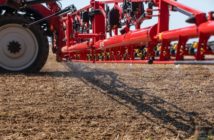Many growers are thinking about soil management and which crops to grow on land that would otherwise be left bare over winter. Frontier agronomist, Harry Abell, explores the options available and what needs to be considered before making any decisions.
“A successful catch or cover crop is treated like any other main crop, grown with the wider farm in mind,” says Mr Abell. “There are several benefits, including improvements to soil health and the availability of paid-for stewardship options.”
“A successful catch or cover crop is treated like any other main crop, grown with the wider farm in mind. There are several benefits, including improvements to soil health and the availability of paid-for stewardship options.”
However, Mr Abell stresses that it’s critical that crops are chosen for the right farm-specific reasons. “Expert advice is essential for decision making. Growers should seek guidance from their agronomist to make use of digital tools such as MyFarm and precision data from SOYL to highlight where cover or catch crops could offer the most benefit.
Think about the end goal
When it comes to adopting catch or cover crops, Harry also notes the importance of thinking about your objectives. “There are several factors to consider. Are you looking to improve soil structure? Do you need to provide additional grazing for livestock? Is grass weed control the priority?
“Along with this, look at the timescale,” he adds. “Is there enough time to plan, purchase and plant a crop during harvest? If so, you could consider a catch crop. If more time is needed, a cover crop could be the solution.
“Finally, review where you want to grow the crops. What’s the topography and soil type, and is there wider support available such as stewardship schemes or grants from local water companies?
“Once you know these answers, you can then choose what to grow – whether it be a single crop, or a multi-species mix.”
Catch crops
Mr Abell explains that catch crops are a short-term solution. They are quick to establish in an eight-to-12-week window, with options including oil radish, mustard or buckwheat.
“For a successful crop, drilling date is essential, sowing the right seed, at the right rate, at the right time.”
Cover crops
For cover crops, Mr Abell encourages growers to consider them as a longer-term component of the farm rotation.
“They offer good break options for grass weed control as well as agronomic benefits such as increasing organic matter levels, capturing vital nutrients and improving soil structure. Consider buckwheat, oats or forage rye – the latter is good when additional grazing for livestock is required.”
For black-grass management, Harry points to the two-year legume fallow AB15 option in Countryside Stewardship.
“The grass species within the mix are easy to manage and will benefit pollinators. They contain late perennial ryegrass, red clover, common vetch, birdsfoot trefoil and common knapweed.
“I’ve also worked with growers who have undersown an AB15 compliant mix with spring barley to allow the mix to establish in time and have seen a positive impact on black-grass levels,” he adds.
As well as the benefits they bring direct to the field, Harry notes cover crops can form a core element of stewardship schemes, providing additional revenue streams.
Mr Abell stresses that it’s critical that crops are chosen for the right farm-specific reasons. “Expert advice is essential for decision making. Growers should seek guidance from their agronomist to make use of digital tools such as MyFarm and precision data from SOYL to highlight where cover or catch crops could offer the most benefit.
Think about the end goal
When it comes to adopting catch or cover crops, Mr Abell also notes the importance of thinking about your objectives. “There are several factors to consider. Are you looking to improve soil structure? Do you need to provide additional grazing for livestock? Is grass weed control the priority?
“Along with this, look at the timescale,” he adds. “Is there enough time to plan, purchase and plant a crop during harvest? If so, you could consider a catch crop. If more time is needed, a cover crop could be the solution.
“Finally, review where you want to grow the crops. What’s the topography and soil type, and is there wider support available such as stewardship schemes or grants from local water companies?
“Once you know these answers, you can then choose what to grow – whether it be a single crop, or a multi-species mix.”
Catch crops
Mr Abell explains that catch crops are a short-term solution. They are quick to establish in an eight-to-12-week window, with options including oil radish, mustard or buckwheat.
“For a successful crop, drilling date is essential, sowing the right seed, at the right rate, at the right time.”
Cover crops
For cover crops, Harry encourages growers to consider them as a longer-term component of the farm rotation.
“They offer good break options for grass weed control as well as agronomic benefits such as increasing organic matter levels, capturing vital nutrients and improving soil structure. Consider buckwheat, oats or forage rye – the latter is good when additional grazing for livestock is required.”
For black-grass management, Harry points to the two-year legume fallow AB15 option in Countryside Stewardship.
“The grass species within the mix are easy to manage and will benefit pollinators. They contain late perennial ryegrass, red clover, common vetch, birdsfoot trefoil and common knapweed.
“I’ve also worked with growers who have undersown an AB15 compliant mix with spring barley to allow the mix to establish in time and have seen a positive impact on black-grass levels,” he adds.
As well as the benefits they bring direct to the field, Harry notes cover crops can form a core element of stewardship schemes, providing additional revenue streams.




